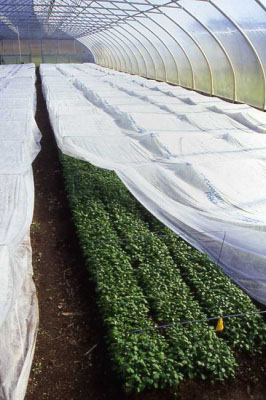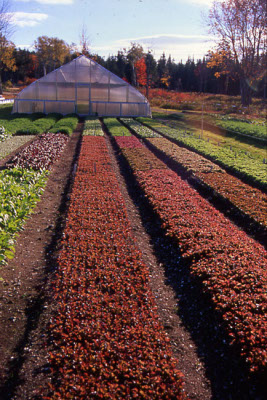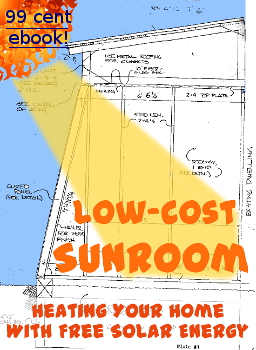
Winter garden protection: Greenhouses and row covers
 The heart of Eliot Coleman's
winter gardening is a two-tiered method of protecting the plants from
winter cold. He grows his vegetables under floating row covers
inside simple greenhouses (hoop houses), and the combination of the two
is the equivalent of moving his garden 1,000 miles south to where it is
three climatic zones warmer. The majority of his growing area ---
and the part I will be discussing in this lunchtime series --- is
completely unheated, but he does note that for some people who have a
cheap source of heat, it might be worthwhile to warm the greenhouses
until they stay just above freezing.
The heart of Eliot Coleman's
winter gardening is a two-tiered method of protecting the plants from
winter cold. He grows his vegetables under floating row covers
inside simple greenhouses (hoop houses), and the combination of the two
is the equivalent of moving his garden 1,000 miles south to where it is
three climatic zones warmer. The majority of his growing area ---
and the part I will be discussing in this lunchtime series --- is
completely unheated, but he does note that for some people who have a
cheap source of heat, it might be worthwhile to warm the greenhouses
until they stay just above freezing.
I've always been leery
of hoop houses and greenhouses because of
disease and pest buildup, and Eliot Coleman notes that permanent
greenhouses also have the side effect of building up soil nutrients to
poisonous levels. By cutting your growing space off from the
outside world, you're promising to keep the ecosystem in balance, which
is a tough job when we haven't even identified all of the
microorganisms at work in our soil. Coleman has a solution ---
let nature do that hard work for you. His greenhouses are light
enough that his tractor can pull them to a new patch of ground a couple
of times a year, allowing nature to heal the wacky greenhouse ecosystem
left behind. His movable greenhouses also have the side benefit
of allowing him to grow heat-loving summer crops in the greenhouse
until late October, then move the greenhouse onto two-month-old fall
crops just as the killing frosts commence --- in essence, he gets
fourteen months of greenhouse time per year for each structure.
The row covers Coleman
uses inside his greenhouse are the same
spun-bonded fabric you can purchase in many seed catalogs and which
you'll see in my garden. (He uses Agribon brand row covers from
Johnny's.) Since the greenhouse blocks wind and heavy weather,
you can simply drape your row covers over twelve inch tall wickets made
of #9 wire and spaced every four feet along the bed. Snap a few
clothespins on to hold the fabric in place, and you're done with your
second tier of protection. Unlike glass-topped cold frames or
cloches, row cover fabric is self-venting and only needs to be removed
when warm spring days in March begin to overheat your crops.
 I was glad to see that
Coleman did some research to determine the best
kind of row cover since I've been confused by all the choices in the
past. Your first decision is whether to choose polyvinyl alcohol
fabric or the simple spun-bonded fabric which is more readily
available. The former has marked advantages of lasting about four
times as long, allowing 90% of light to pass through (versus 30 to
85%), and keeping the air underneath about one degree warmer, but with
a price tag five times higher, polyvinyl alcohol probably isn't worth
it.
I was glad to see that
Coleman did some research to determine the best
kind of row cover since I've been confused by all the choices in the
past. Your first decision is whether to choose polyvinyl alcohol
fabric or the simple spun-bonded fabric which is more readily
available. The former has marked advantages of lasting about four
times as long, allowing 90% of light to pass through (versus 30 to
85%), and keeping the air underneath about one degree warmer, but with
a price tag five times higher, polyvinyl alcohol probably isn't worth
it.
Next choice is --- light
fabric or heavy fabric? In the seed
catalogs, you'll see the heavy fabrics listed as protecting your plants
several degrees colder, but in Coleman's experience, these heavy
fabrics block so much of the sun's light that the ground actually ends
up colder in the long run. Instead, he recommends the thinnest
row covers, which are rated as protecting your plants only down to 28
degrees Fahrenheit, but which Coleman said provide increasing amounts
of protection as the weather gets colder.
I won't go into the
specifics of Coleman's greenhouse construction
since his scale of greenhouse --- 48 feet by 22 feet --- is beyond the
scope of our homestead garden. If you want to know more, check
his book out of the local library, or visit his website (from which I snagged these
photos.) Or stay tuned for tomorrow's
post, in which I'll consider ways to apply Coleman's method to the
backyard.
 This post is part of our Winter Harvest Handbook lunchtime series.
Read all of the entries: This post is part of our Winter Harvest Handbook lunchtime series.
Read all of the entries: |
Want more in-depth information? Browse through our books.
Or explore more posts by date or by subject.
About us: Anna Hess and Mark Hamilton spent over a decade living self-sufficiently in the mountains of Virginia before moving north to start over from scratch in the foothills of Ohio. They've experimented with permaculture, no-till gardening, trailersteading, home-based microbusinesses and much more, writing about their adventures in both blogs and books.
Want to be notified when new comments are posted on this page? Click on the RSS button after you add a comment to subscribe to the comment feed, or simply check the box beside "email replies to me" while writing your comment.

Hello Anna, thank you so much for your info on Coleman's use of the "house within a house" - I am looking forward to your thoughts on how to apply on a smaller scale. Jackie
Jackie --- I hope my later posts gave you some good ideas for your garden. We're looking forward to trying it out.
Roland --- I'd actually never heard of the stuff before reading the book. I'm used to the lower end fabric, which falls apart way too fast. Maybe PVA will become more available soon and fix that pesky problem.